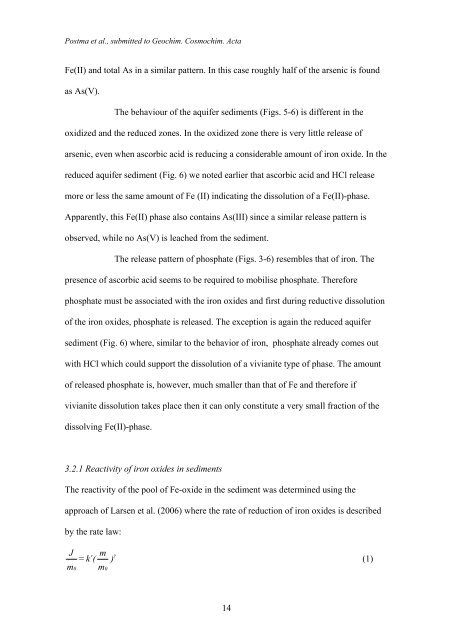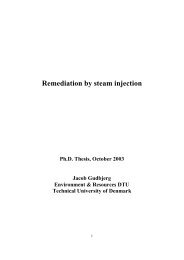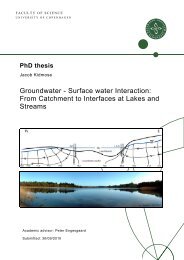Groundwater arsenic in the Red River delta, Vietnam ... - Fiva
Groundwater arsenic in the Red River delta, Vietnam ... - Fiva
Groundwater arsenic in the Red River delta, Vietnam ... - Fiva
You also want an ePaper? Increase the reach of your titles
YUMPU automatically turns print PDFs into web optimized ePapers that Google loves.
Postma et al., submitted to Geochim. Cosmochim. Acta<br />
Fe(II) and total As <strong>in</strong> a similar pattern. In this case roughly half of <strong>the</strong> <strong>arsenic</strong> is found<br />
as As(V).<br />
The behaviour of <strong>the</strong> aquifer sediments (Figs. 5-6) is different <strong>in</strong> <strong>the</strong><br />
oxidized and <strong>the</strong> reduced zones. In <strong>the</strong> oxidized zone <strong>the</strong>re is very little release of<br />
<strong>arsenic</strong>, even when ascorbic acid is reduc<strong>in</strong>g a considerable amount of iron oxide. In <strong>the</strong><br />
reduced aquifer sediment (Fig. 6) we noted earlier that ascorbic acid and HCl release<br />
more or less <strong>the</strong> same amount of Fe (II) <strong>in</strong>dicat<strong>in</strong>g <strong>the</strong> dissolution of a Fe(II)-phase.<br />
Apparently, this Fe(II) phase also conta<strong>in</strong>s As(III) s<strong>in</strong>ce a similar release pattern is<br />
observed, while no As(V) is leached from <strong>the</strong> sediment.<br />
The release pattern of phosphate (Figs. 3-6) resembles that of iron. The<br />
presence of ascorbic acid seems to be required to mobilise phosphate. Therefore<br />
phosphate must be associated with <strong>the</strong> iron oxides and first dur<strong>in</strong>g reductive dissolution<br />
of <strong>the</strong> iron oxides, phosphate is released. The exception is aga<strong>in</strong> <strong>the</strong> reduced aquifer<br />
sediment (Fig. 6) where, similar to <strong>the</strong> behavior of iron, phosphate already comes out<br />
with HCl which could support <strong>the</strong> dissolution of a vivianite type of phase. The amount<br />
of released phosphate is, however, much smaller than that of Fe and <strong>the</strong>refore if<br />
vivianite dissolution takes place <strong>the</strong>n it can only constitute a very small fraction of <strong>the</strong><br />
dissolv<strong>in</strong>g Fe(II)-phase.<br />
3.2.1 Reactivity of iron oxides <strong>in</strong> sediments<br />
The reactivity of <strong>the</strong> pool of Fe-oxide <strong>in</strong> <strong>the</strong> sediment was determ<strong>in</strong>ed us<strong>in</strong>g <strong>the</strong><br />
approach of Larsen et al. (2006) where <strong>the</strong> rate of reduction of iron oxides is described<br />
by <strong>the</strong> rate law:<br />
J m <br />
= k´<br />
( )<br />
(1)<br />
m0<br />
m0<br />
14





